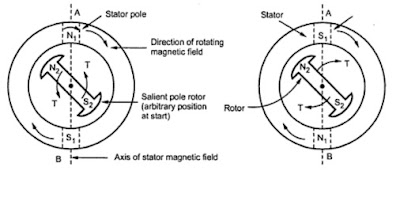Let us consider a 3-phase induction motor first and see how it rotates. A 3- phase supply given to the armature of Induction Motor produces a rotating magnetic field. This rotating magnetic field rotates at synchronous speed Ns = (120xf)/P
Thus we see that Induction Motor is self-starting. It does not require nay external mean to rotate.
Now we consider a 3-phase synchronous motor. A 3-phase supply is given to the armature of Synchronous Motor, produces a rotating magnetic field. However, in this case, the rotor has its own field produced by a DC current flowing through the rotor winding. This rotor field tends to align itself along with the rotating magnetic field produced by the stator i.e. armature winding. North pole of rotor tries to lock with the South pole of stator and South pole of Rotor tries to align along the North of Stator.
The North Pole of rotor tries to chase the South Pole of stator. But the stator magnetic field is rapidly rotating at synchronous speed, and before the North Pole of rotor could lock with South Pole of stator, the stator field has shifted position so that its North (stator) comes in the vicinity of North Pole of rotor and they repel as shown in figure below.
Because the rotor has certain inertia and the speed of the rotating magnetic field is too fast for it to catch up, it ends up vibrating. So Synchronous Motor fails to start.
So what do you do for starting a Synchronous Motor?
- We can give a reduced frequency supply to the stator, this will reduce the speed of rotation of the stator magnetic field and the rotor will easily catch up, once the rotor catches up we may increase the frequency.
- We can manually rotate the rotor till it catches speed near to synchronous speed and eventually locks the rotor field with the stator field.
- We can use Amortsieur Windings. The concept is to start the motor as an induction motor. Initially no DC field excitation is given and the motor operates as an induction motor. Once it attains some speed near to synchronous speed, DC excitation is given and the rotor field aligns itself with the stator field, and rotor attains synchronous speed.
